1. Introduction
 OCZ is a company that is gaining more and more of the limelight every day. This has been achieved through carefully planned marketing strategies coupled with quality products that exceed every demanding user's highest expectations. Some unique and innovative products that have the OCZ signature include the DDR Power Booster, high quality memory modules and their new line of high quality power supplies.
OCZ is a company that is gaining more and more of the limelight every day. This has been achieved through carefully planned marketing strategies coupled with quality products that exceed every demanding user's highest expectations. Some unique and innovative products that have the OCZ signature include the DDR Power Booster, high quality memory modules and their new line of high quality power supplies.
We recently received OCZ's DDR2 PC2-4200 Gold GX XTC Dual Channel modules, a new pair of modules with very promising features.

According to the manufacturer, the new OCZ PC2-4200 Gold Edition was developed with gamers’ distinctive needs in mind. The latest generation of PC games, such as Battlefield 2, Half Life 2 and Doom 3, require large capacity memory to deliver the most powerful, stable system performance. The PC-4200 Gold Edition is the ultimate memory solution for contemporary graphics-intensive PC titles and provides unsurpassed reliability and performance to unleash every graphics possibility.
The new OCZ PC2-4200 Gold GX Edition utilizes the latest OCZ heatspreader design. XTC (Xtreme Thermal Convection) Heatspreaders allow increased ventilation and heat dissipation due to an innovative honeycomb design providing more direct access to the actual memory ICs.

As part of the award winning OCZ Gold GX series, the PC2-4200 Gold DDR2 edition is built with leading edge technology designed and qualified with special selection of premium components to maximize performance when playing even the most demanding games. As DDR2-533, these modules turn out heart-pounding 4-4-4 timings with flawless performance and stability.
OCZ PC2-4200 products are 100% hand-tested to ensure compliance with stringent quality standards. In addition, each member of the OCZ Gold GX PC2-4200 family is backed by an industry-leading lifetime warranty, toll-free technical support and the exclusive EVP® (Extended Voltage Protection) coverage.


Specifications
- 533MHz DDR2
- CL 3-3-3-12 (CAS-TRCD-TRP-TRAS)
- Available in a 512MB and 1GB module
- Unbuffered
- Gold Layered XTC* Heatspreader
- Lifetime Warranty
- 1.9 Volts
- 240 Pin DIMM
* XTC (Xtreme Thermal Convection) heatspreaders optimize the thermal management of memory modules by promoting greater airflow by means of micro-convection throughout what is usually the dead air space inside conventional heatspreader designs. In this manner, build-up of heat is avoided and thermal dissipation of the memory components is offloaded more efficiently through the honeycomb design. At the same time, mechanical stability is maintained.
Special Features
EVP : (Extended Voltage Protection) is a feature that allows performance enthusiasts to use a VDIMM of 2.2V ± 5% without invalidating their OCZ Lifetime Warranty.

2. Test System - Configuration
In order to test the new DDR2 PC2-4200 Gold GX XTC Dual Channel modules, we used our ASUS motherboard, the P5WD2 Premium, based on the 955X chipset, and an Intel Pentium 4, 640 running at 3.2 GHz. Below are some screenshots from CPU-Z v1.31:



The first tests were done with the speed at 533 MHz and timings of 4-4-4-12, a setting which is automatically detected from the SPD. Below, you can see further details for the memory and the CPU:
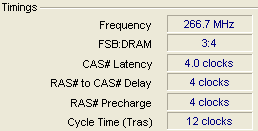
The next step was to set the timings according to specifications, at 3-3-3-12. This way, we could check the differences in performance by adjusting only the timings. The memory speed remained at 533 MHz.
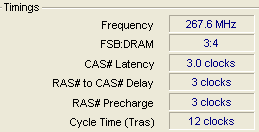
The specific timings are rather low for DDR2 modules, so it would be rather interesting to check what would be the limit for the timings, when increasing the memory speed. After several tests, we found that the limit for 3-3-3-12 was at 600 MHz. Higher frequencies reported errors in Memtest86+ early on. In order to do this, we also adjusted the CPU settings, FSB and Voltage. We set the FSB for the CPU at 248 MHz and the Core Speed was raised up to 3.85 GHz.


Finally, we tried to check the frequency limit for the OCZ modules, with the timings at 4-4-4-12. After many retries, we managed to set the memory speed to 701 MHz. The FSB for the CPU was at 263 MHz and the Core Speed at 4.21 GHz. Not bad at all for 533 MHz certified memory and a 3.2 GHz CPU.


| Memtest86+ v1.60 Memory Bandwidth (MB/s) |
| 533 - 4.4.4.12 (SPD) |
2606 |
| 533 - 3.3.3.12 |
2787 |
| 600 - 3.3.3.12 |
3005 |
| 701 - 3.3.3.12 |
3230 |
| 728 - 3.3.3.12 |
3353 |
For convenience, in the following pages we will refer to them as SPD, 533, 600 and 701. With the memory running at 728 MHz, we didn't take any measurements since Windows couldn't boot. According to Memtest86+, this was definitely not a memory issue. At 733MHz for example, it reported errors. It seems that we had exceeded the limits of our Intel processor and the cooling system we used for these tests. Just for reference, the Core Speed was at 4.37 GHz with the FSB set at 273 MHz.
Here's a rundown of our testbed:
System Specifications
CPU: Intel Pentium 4 640 3.20 GHz
Cooler: Thermaltake Blue Orb II
Case: none
Motherboard: Asus P5WD2 PREMIUM
Power supply: Thermaltake PurePower 520W
Memory: DDR2 PC2-4200 Gold GX XTC Dual Channel
VGA: Aopen Aeolus 6800Ultra PCI-E
Hard Disk Drive: WD800JD 80GB 7200RPM
OS: Windows XP Pro SP2
Drivers: 7.1.8.4
DirectX: v9.0c
Benchmarks & Applications used
Memtest86+-1.60
Sisoft Sandra 2005
PcMark05
Performance Test V5.0 ( PassMark)
Half Life 2 - VST
CPU-Z v1.31
3. SiSoftware Sandra 2005
 SiSoftware Sandra is a 32 and 64-bit Windows system analyser that includes benchmarking, testing and listing modules. It tries to go beyond other utilities to show you more of what is really going on under the hood so you draw comparisons at both a high and low-level in a single product.
SiSoftware Sandra is a 32 and 64-bit Windows system analyser that includes benchmarking, testing and listing modules. It tries to go beyond other utilities to show you more of what is really going on under the hood so you draw comparisons at both a high and low-level in a single product.
You can get information about the CPU, chipset, video adapter, ports, printers, sound card, memory, network, Windows internals, AGP, ODBC Connections, USB2, Firewire etc.
You can save/print/fax/e-mail/post/upload or insert into ADO/ODBC databases reports in text, HTML, XML, SMS/DMI or RPT format.
This version supports multiple sources of information gathering including: remote computers, PDAs, Smart Phones, ADO/ODBC databases or saved system reports.
All benchmarks are optimised for both SMP & SMT (Hyper-Threading), up to 32/64 CPUs depending on the platform.
Memory Bandwidth Benchmark
Tests how your memory sub-system compares to other systems with the same or similar memory in other systems. The benchmark is based on the well-known STREAM memory bandwidth benchmark. (Higher is better, i.e. better performance).
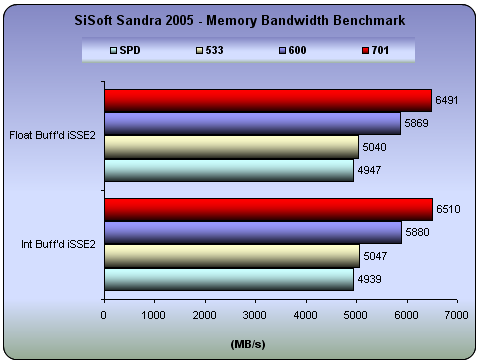
The lower timings, from 4-4-4-12 to 3-3-3-12, with the same memory speed at 533 MHz, reported better performance. So even if you don't want to overclock your system and change the memory speed, you'll still gain by simply lowering the timings. But setting the memory frequency to 701 MHz will boost the performance greatly.
Cache & Memory Benchmark
Tests how your CPU cache and memory sub-system(s) compares to other systems with the same or similar CPU & memory in other systems. The benchmark is based on the Memory Bandwidth Benchmark test.
Combined Index: is a composite figure representing the overall performance rating of the entire Cache-Memory performance in terms of MB/s. The value is the logarithmic average of all the results for the entire address space. (Higher is better, i.e. better performance)
For block sizes that could not been tested - the average of previous blocks is used, thus the size of the memory (as long as it is not comparable to largest cache size) is not significant; all cache sizes are significant - larger caches will result in a higher index.

Same results here also. Lowering the timings initially makes a difference, but overclocking does so even more.
Speed Factor: is a figure representing the speed differential between the CPU’s cache and memory. The value is the ratio of the fastest cache (i.e. L1) bandwidth to the main memory bandwidth. (Lower is better, i.e. the memory is not very much slower than the CPU’s cache).
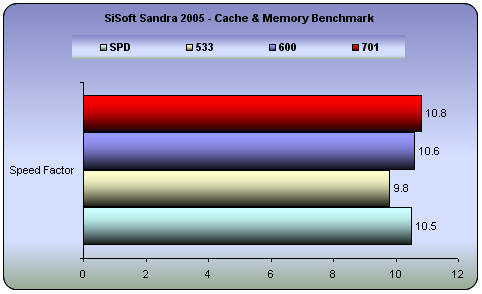
The default memory frequency and 3-3-3-12 timings yield better results.
4. PCMark05
PCMark05 is an application-based benchmark and a premium tool for measuring overall PC performance. It uses portions of real applications instead of including very large applications or using specifically created code. This allows PCMark05 to be a smaller installation as well as to report very accurate results. As far as possible, PCMark05 uses public domain applications whose source code can be freely examined by any user.

PCMark05 includes 4 categorized suites for benchmarking your computer. These include CPU, Graphics, Memory and a Hard Disk Drive benchmark. In our case, we selected to run only the Memory test suite.
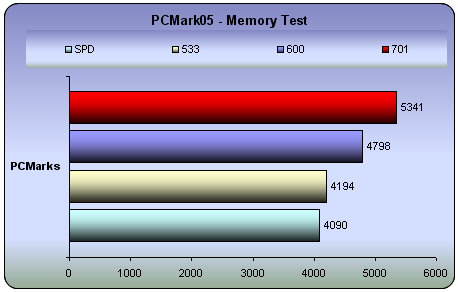
Slightly better performance with the lower timings. See how many PCMarks difference there is between the normal 533/3-3-3-12 and the overclocked settings of 701/4-4-4-12. This is more noticeable in the following table.
| PCMark05 Memory Test |
SPD |
533 |
600 |
701 |
| Memory Read 16MB (MB/s) |
6075.582 |
6205.491 |
7014.274 |
7958.627 |
| Memory Read 8MB (MB/s) |
6406.421 |
6577.926 |
7413.110 |
8396.770 |
| Memory Read 192KB (MB/s) |
25150.959 |
25245.230 |
30179.357 |
33071.785 |
| Memory Read 4KB (MB/s) |
42078.898 |
42235.941 |
50629.973 |
54825.168 |
| Memory Write 16MB (MB/s) |
4017.910 |
4039.432 |
4815.410 |
5244.419 |
| Memory Write 8MB (MB/s) |
4024.651 |
4036.327 |
4816.421 |
5294.441 |
| Memory Write 192KB (MB/s) |
10761.424 |
10798.358 |
12930.479 |
14183.286 |
| Memory Write 4KB (MB/s) |
10815.565 |
10817.952 |
12978.836 |
14255.510 |
| Memory Copy 16MB (MB/s) |
4330.231 |
4535.864 |
4882.204 |
5650.584 |
| Memory Copy 8MB (MB/s) |
4332.603 |
4496.229 |
4683.905 |
5396.824 |
| Memory Copy 192KB (MB/s) |
8973.796 |
8983.383 |
10733.932 |
11791.171 |
| Memory Copy 4KB (MB/s) |
10792.621 |
10804.696 |
12968.026 |
14199.596 |
| Memory Latency 16MB (MAccesses/s) |
8.802 |
9.844 |
9.899 |
11.420 |
| Memory Latency 8MB (MAccesses/s) |
9.317 |
10.607 |
10.569 |
12.017 |
| Memory Latency 192KB (MAccesses/s) |
136.394 |
136.872 |
163.976 |
179.660 |
| Memory Latency 4KB (MAccesses/s) |
799.481 |
802.304 |
961.221 |
1053.108 |
5. Performance Test v5.0
 Passmark PerformanceTest is an award winning PC hardware benchmark utility that allows everybody to quickly assess the performance of their computer and compare it to a number of standard 'baseline' computer systems.
Passmark PerformanceTest is an award winning PC hardware benchmark utility that allows everybody to quickly assess the performance of their computer and compare it to a number of standard 'baseline' computer systems.
Twenty seven standard benchmark tests are available in seven test suites plus there are five advanced testing windows for custom benchmarking. CPU Tests, 2D Graphics Tests, 3D Graphics Tests, Disk Tests, Memory Tests and CD/DVD Tests. In our case we selected the Memory suite Tests.
- Memory Benchmarks
This suite contains a number of tests that exercise the memory sub-system of the computer. (Random Access Memory- RAM)
Memory - Allocate small block
This test measures the time taken to allocate & free small zeroed memory blocks (around 100KB block size)
Memory - Cached
This test measures the time taken to read a small block of memory. The block is small enough to be held entirely in cache (if one is present)
Memory - UnCached
This test measures the time taken to read a large block of memory. The block is too large to be held in cache.
Memory - Write
This test measures the time taken to write information into memory.
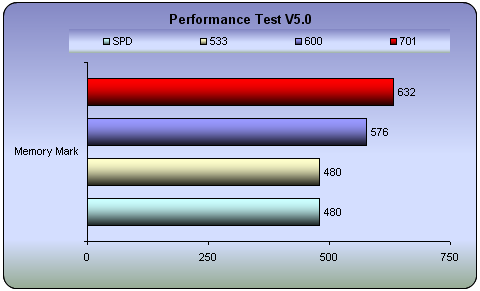
This is the only test that reported almost similar performance between 533/4-4-4-12 and 533/3-3-3-12.
- Advanced Memory Benchmark
Memory Speed Per Access Step Size
The first test type, ‘Memory Speed Per Access Step Size’ accesses a large block, of memory in various sized steps. First, it runs through the block of memory sequentially, accessing every value. Next it runs through the same block again, except this time it accesses every second value. On this occasion, it runs through the block twice in order to access the same amount of data as the initial step. Next it runs through the same block again, except this time it accesses every fourth value and so makes four passes. And so on, until a certain maximum step size is reached.
The size of the block of memory used for this test is one quarter the amount of system RAM. The size of the steps varies from 1 (continuous sequential access), to one quarter the size of the block of memory ( i.e. one sixteenth of the system RAM ).
| Memory Speed (MB/Sec. per Step Size) |
SPD |
533 |
600 |
701 |
| OCZ |
| Block Read Speed |
34.11 |
34.73 |
40.33 |
44.26 |
| Block Write Speed |
21.80 |
21.99 |
25.50 |
27.96 |
Memory Speed Per Block Size
When a computer program wants to use a section of memory to store data, it makes a request to Windows for the amount of memory it requires. Windows allocates the memory to the program ( unless system resources are very low ) and returns to the requesting program the address of the first memory slot in the allocated block. It is possible that some programs may request very large amounts of memory. The ‘Memory Speed Per Block Size’ test like the ‘Memory Speed Per Access Step Size’ test, is composed of many steps. During each step of the test, PerformanceTest requests a block of memory and runs through the block measuring the average access time. However on each subsequent step the size of the requested memory is increased, until finally a block close to the size of the system RAM is requested. In this way it is possible to observe the different access speeds for the different sizes of blocks.
Typically it is possible to see very fast memory access for blocks which are small enough to fit entirely into the L2 RAM cache, and slower access times for larger blocks accessed from main RAM. In the case where system resources are low, swapping to the disk may even be required for very large blocks.
| Memory Speed (MB/Sec. per Block Size) |
SPD |
533 |
600 |
701 |
| OCZ |
| Block Read Speed |
368.98 |
369.68 |
441.93 |
485.16 |
| Block Write Speed |
255.60 |
256.19 |
306.91 |
336.08 |
There is huge gain when overclocking the modules.

6. Half Life 2
 Half life 2 is without doubt the most anticipated pc game of all times.
Half life 2 is without doubt the most anticipated pc game of all times.
Physics - From pebbles to water to 2-ton trucks respond as expected, as they obey the laws of mass, friction, gravity, and buoyancy.
Graphics - Source's shader-based renderer, like the one used at Pixar to create movies such as Toy Story® and Monster's, Inc.®, creates the most beautiful and realistic environments ever seen in a video game.
AI - Neither friends nor enemies charge blindly into the fray. They can assess threats, navigate tricky terrain, and fashion weapons from whatever is at hand.

With games, the increased FSB in combination with the higher memory speed, boosted performance. Lower resolutions are a better indication since there is no demand from the graphics card. At these stages, there is a 40 fps difference. But even at points where the graphics card comes into play, the difference is still around 17 fps.

7. Conclusion
The new Gold GX XTC modules are very well designed and will certainly improve the look, albeit internally of your case. The overall performance of the DDR2 PC2-4200 Gold GX XTC Dual Channel modules was good at all speeds. Note that the certified speed is at 533 Mhz but we managed to overclock them, right up to 728 MHz!!!
In SiSoft Sandra 2005, the DDR2 PC2-4200 Gold GX XTC Dual Channel modules achieved a score of 6491MB/s and 6510MB/s in the RAM Bandwidth ,Integer and Floating Point benchmarks respectively, while in the Combined Index, the reported 11976MB/s was also good. In PCMar05, the 5341 PCMarks is an excellent score, even better than Kingmax's DDR2 667 MHz modules. In games, the increased memory speed in combination with the overclocked CPU will increase the frame rate, as happened in our HL2 test where we saw a jump of approximately 40fps when going from 533MHz to 701MHz.

On the e-market, the price for the OCZ25331024ELGEGXT-K modules is close to US$120. A reasonable price and excellent performance make this product a great offer.
